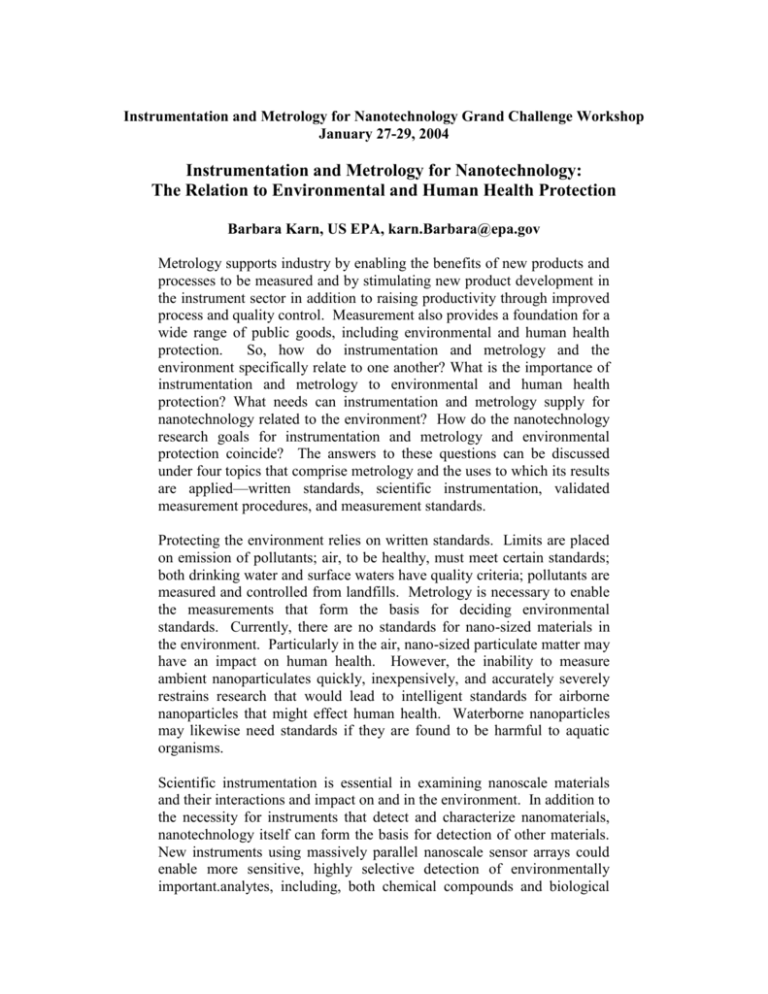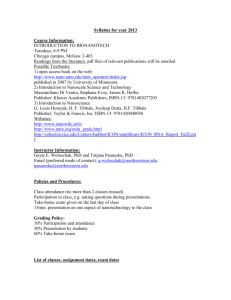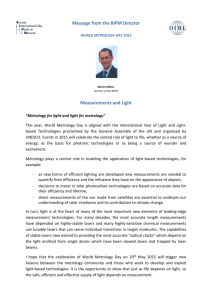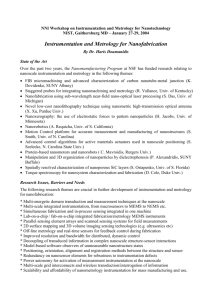Karn-EPA-metrology and the environment-1
advertisement

Instrumentation and Metrology for Nanotechnology Grand Challenge Workshop January 27-29, 2004 Instrumentation and Metrology for Nanotechnology: The Relation to Environmental and Human Health Protection Barbara Karn, US EPA, karn.Barbara@epa.gov Metrology supports industry by enabling the benefits of new products and processes to be measured and by stimulating new product development in the instrument sector in addition to raising productivity through improved process and quality control. Measurement also provides a foundation for a wide range of public goods, including environmental and human health protection. So, how do instrumentation and metrology and the environment specifically relate to one another? What is the importance of instrumentation and metrology to environmental and human health protection? What needs can instrumentation and metrology supply for nanotechnology related to the environment? How do the nanotechnology research goals for instrumentation and metrology and environmental protection coincide? The answers to these questions can be discussed under four topics that comprise metrology and the uses to which its results are applied—written standards, scientific instrumentation, validated measurement procedures, and measurement standards. Protecting the environment relies on written standards. Limits are placed on emission of pollutants; air, to be healthy, must meet certain standards; both drinking water and surface waters have quality criteria; pollutants are measured and controlled from landfills. Metrology is necessary to enable the measurements that form the basis for deciding environmental standards. Currently, there are no standards for nano-sized materials in the environment. Particularly in the air, nano-sized particulate matter may have an impact on human health. However, the inability to measure ambient nanoparticulates quickly, inexpensively, and accurately severely restrains research that would lead to intelligent standards for airborne nanoparticles that might effect human health. Waterborne nanoparticles may likewise need standards if they are found to be harmful to aquatic organisms. Scientific instrumentation is essential in examining nanoscale materials and their interactions and impact on and in the environment. In addition to the necessity for instruments that detect and characterize nanomaterials, nanotechnology itself can form the basis for detection of other materials. New instruments using massively parallel nanoscale sensor arrays could enable more sensitive, highly selective detection of environmentally important.analytes, including, both chemical compounds and biological organisms such as algae, bacteria, or viruses. Instrumentation is needed for monitoring nanomaterials in ambient environments in order to determine the fate, transport and transformations of these substances. Current metrology instrumentation for nanotechnology involves integrated use of biological principles, physical laws, and chemical properties. These three aspects are also integrated into environmental science, and any furtherance of the integrative science will also further fundamental research in the environment. Validated measurement procedures are necessary for quality control in monitoring and analyzing environmental samples. If emissions standards are necessary, there must be reasonable means for effected industries and organizations to measure nanoparticles for compliance requirements. Measurement procedures also help the environment by increasing the efficiency of manufacturing processes, thereby producing less waste that could harm the environment. Measurement standards are essential for research to proceed in nanotechnology related to the environment. If there is no standardization, there is no comparability among the numerous research laboratories involved in examining nano-scale science and its relation to the environment. Measurement standards are also needed for quality control during monitoring. The importance of measurement in the environment at the nanoscale was discussed at last year’s workshop on Nanotechnology Grand Challenge in the Environment. May 8-9, 2003. One of the five major discussion topics was Nanotechnology Applications for Measurement in the Environment as applied to sensors, monitors, models, separations, detection, fate and transport, data gathering and dissemination. The vision statement of this workshop group says:”The unique properties of nanoscale materials will enable the development of a new generation of environmental sensing systems. In addition, measurement science and technology will enable the development of a comprehensive understanding of the interaction and fate of natural and anthropogenic nanoscale and nanostructured materials in the environment.” Research needs were identified in five areas: (1) biological sensor technologies that are sufficiently stable to allow detection in situ on a continuous basis for high-density usage; (2) a general “array” for detection of a wide variety of potential analytes; (3) information concerning the diversity of chemical composition at the nanoparticles level, and the transformations that occur and measurement techniques that distinguish the chemical composition of particle surface layers from the particle interior; (4) generic nanoscale assembly methods; and (5) advances in spectroscopic instrument technologies that allow rapid detection of low signal strength, while probing smaller volumes of a nanoparticulate sample. Measurement is fundamental to the progress and quality of all scientific endeavors and engineering applications. It provides an underlying foundation for research in environmental and human health protection. Advances in metrology to both measure nanoscale materials and to use nanotechnology in measurement goes hand in hand with advancing the protection of the environment and human health.





